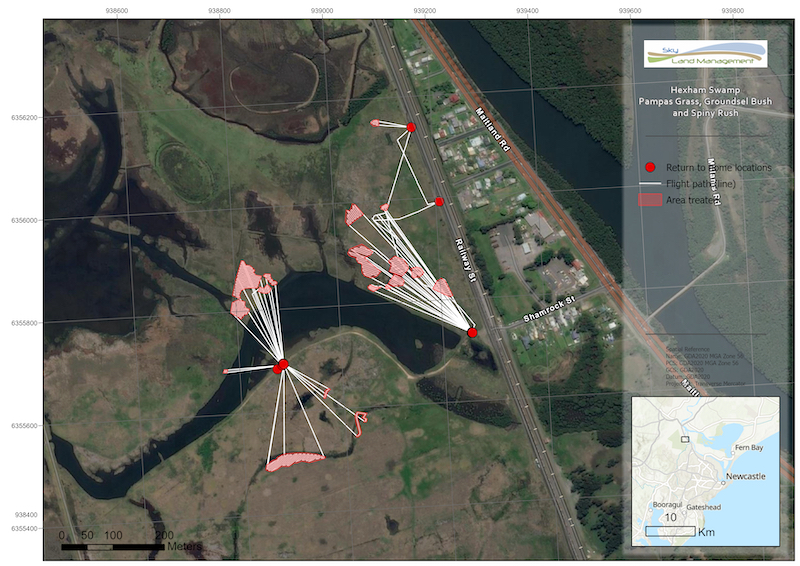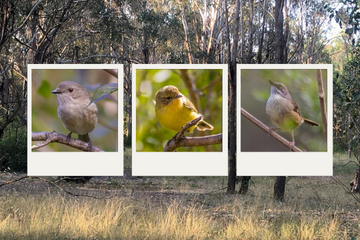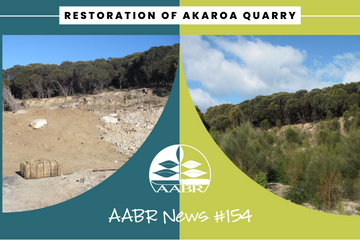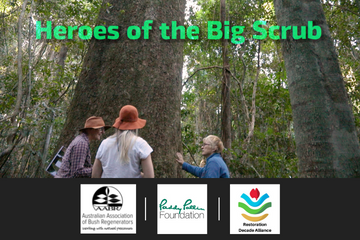Above Images:Before and after view from Norah Head light tower upper balcony, looking south-west along the reserve towards the abandoned quarry. Prior to works (April 2011) the Bitou Bush is clearly as the yellow flowering shrub throughout. Two years after primary and follow up works (July 2013) more than 90% of Bitou Bush has been removed.
In April 2011, works commenced on the restoration of a 14 ha site surrounding Norah Head Lighthouse, located on a prominent coastal headland located in the Wyong Shire, NSW. The local Darkinjung people place great significance to this landscape and traces of pre-colonial history remain throughout the reserve.
Prior to works. The native vegetation on the restoration site could be characterised as a mosaic of Coastal Dune Grassland, Coastal Heath and Littoral Rainforest. Prior to works it was, heavily infested with Bitou Bush (Chrysanthemoides monilifera ssp rotundata), Lantana (Lantana camara) and a host of other introduced plant species. To the south, a former gravel quarry remained largely denuded of vegetation. Road and track development, filling & levelling, ocean outfall works and historic lighthouse construction have impacted the northern portion of the reserve.
Works. Contract works commenced in the former quarry area and extended down-slope of the volunteer managed areas in the northern section of the site. Selective foliar spray of dense Bitou Bush with a Gas Gun was undertaken in accessible areas, whilst leaving Bitou Bush barriers to unwanted pedestrian access and barriers to protect more sensitive native vegetation from strong salt-laden coastal winds. Hand removal of Bitou Bush, Lantana, Ochna (Ochna serrata), Cape Ivy ( Delairea odorata and other weed species, was undertaken among dense native vegetation where off-target damage would be excessive (see photos 1-3).
Access throughout the site proved extremely difficult with dense long-term weed infestation, senescing and collapsed Coast Ti-tree (Leptospermum laevigatum) thickets and steep, erodible coastal cliffs and slopes – some requiring abseil rope access.
As the Bitou Bush and Lantana skeletons dried to a brittle state they were trampled to provide a ground-layer of mulch, this also facilitated access . Post clearing germination flushes of Bitou Bush were controlled by a mix of spot foliar spraying and hand removal, the latter done in order to preserve native seedling recruitment. Repeated hand-pulling provides gentle soil disturbance to ‘trigger’ additional regeneration.
Planting has been undertaken in areas that have lower resilience due to soil and hydrology change. The planted areas are principally on the top edge of the site, adjacent to lighthouse development. Additionally, direct seeding and transplanting have been used to good effect by the volunteers. Native ground covers including Weeping Grass (Microleana stipoides), Kangaroo Grass, (Themeda australis), Beach Bean (Canavalia maritime), Coastal Wattle (Acacia sophorae), Pigface (Carpobrotus glaucescens), and Flax Lily (Dianella caerulea) have been direct seeded, with Prickly Couch (Zoysia macrantha) and Pigface transplanted during the cooler months.
Ongoing erosion control issues have been associated with the highly erodible substrates. Coir fibre ‘Ecologs’ and post-consumer potato sacks have been utilised to stem water based erosion while dead branches removed from Coast Ti-tree thickets have been used to block unwanted pedestrian access to the beaches & the quarry.
Above images: Before and after treatment – with Bitou Bush replaced by native grasses.
Results. Double the area was managed within the first 2 years than was anticipated, with about 0.1ha planted (with 80% survival rate) and 0.2 ha direct seeded. Control of Bitou Bush was substantial within two years (see photos 1 to 6), although longer term treatment is still required before the site can be said to be reduced to low levels.
Groundcovers, vines, shrubs and trees are regenerating. Species include wallaby grasses (Danthonia spp.), Prickly Couch, Dusky Coral Pea (Keneddia rubicunda), Coastal rosemary (Westringia fruticosa), Swamp Oak (Casuarina glauca) and Coast Banksia (Banksia integrifolia).
Acknowledgements
Bushland & Rainforest Restoration & Consulting (BARRC) as the principal Bush Regeneration contractors with assistance from local volunteers, Darkinjung LALC. The project was managed by Norah Head Lighthouse Reserve Trust and the Norah Head Coastare volunteers (headed by Cate Inwood). The project received a 3 year Restoration & Rehabilitation Community Grants Program through the NSW Environmental Trust.
Contact: Scott Meier, Bushland & Rainforest Restoration & Consulting (BARRC). Email: admin@barrc.com.au. Mob 0414 395 419







Leave A Comment